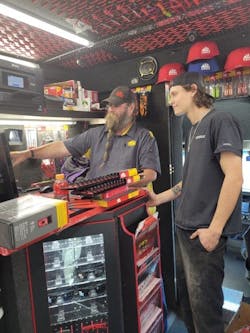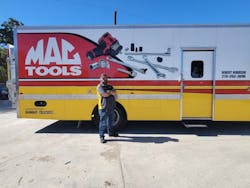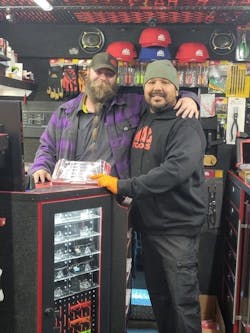Key Highlights
- Distributors prioritize understanding shop owners' needs and timing to facilitate long-term investments rather than impulse purchases.
- Building trust through follow-up support and ongoing education encourages repeat business and deeper partnerships.
- Focusing on measurable ROI, such as increased efficiency and reduced cycle times, helps shop owners see the value of capital equipment.
- Training programs like TEXA EDU are vital for maximizing the benefits of advanced diagnostic and ADAS systems, ensuring technicians are confident and competent.
- Digital tools and ROI calculators from manufacturers assist distributors in tailoring presentations and demonstrating long-term value to customers.
For tool distributors, few things are more satisfying than closing a big-ticket sale such as a vehicle lift, tire changer, or diagnostic system. These purchases take more than a polished pitch. They depend on timing, trust, and a real understanding of what shop owners need.
Capital equipment has become both a necessity and a challenge for many repair businesses. Shops are keeping pace with ADAS, hybrids, and EVs while facing rising costs and thinner margins. Every investment must earn its keep through efficiency, reliability, and a clear return.
The right piece of equipment can change how a shop operates. A new lift can add bays and capacity. A diagnostic system can bring outsourced work back in-house. A balancer or aligner can speed up workflow and free technicians to take on more repairs. These are not impulse buys but long-term decisions that affect the bottom line.
Distributors are often the link between that technology and the technicians who depend on it. Their role goes far beyond selling. They help shop owners identify what will keep their business running smoothly and growing. Manufacturers support that process through training and information that help distributors present the full picture of value.
To learn how those efforts come together, we spoke with Robert Robinson, a Mac Tools distributor based in Boerne, Texas; Kevin Keefe, director of marketing for Coats; Denis White, TEXA EDU manager; and Jeff Kritzer, president and CEO of BendPak. Each offers a perspective on how relationships, education, and return-on-investment conversations drive capital equipment sales.
A distributor’s perspective
For Robert Robinson, selling major equipment starts with curiosity.
“The general approach, honestly, is don’t be afraid to ask,” Robinson says. “I look for things in a shop that could be running better and make suggestions. It’s about planting the seed. You might not get a yes today, but it grows into a sale later.”
Robinson has spent more than ten years as a mobile tool dealer and two decades as an automotive technician. His customers include independent repair shops, dealerships, and fleet operations throughout the Texas Hill Country near San Antonio. Over the years, he has learned that price is rarely the real hurdle.
“If it’s just an expenditure, then it costs money,” he says. “But if it’s an investment, it’s something they can make money with.”
He often starts by identifying where a shop might be losing revenue. If a technician is sending out ADAS calibrations or diagnostic jobs several times a week, he breaks down what that costs over a year and compares it to the price of owning the equipment.
“When you show them the math, it clicks,” Robinson says. “You’re not pushing them. You’re showing them where it makes sense.”
That practical approach has helped him sell several high-end diagnostic systems and lifts in recent months. But for Robinson, the sale is only the start of the relationship.
“It’s not just getting the sale,” he says. “It’s following up afterward. If something goes wrong down the road, they know they can call me.”
He makes it a point to stay in touch long after delivery, checking that customers are comfortable with the new setup or know where to find support. That extra step, he said, often leads to the next opportunity.
“You have to talk to the managers and owners,” he says. “Help them stay ahead by showing what’s new and how it fits their shop.”
He added that success often builds on itself. A lift sale can lead to a diagnostic tool upgrade, and a diagnostic sale can open the door to an alignment system conversation. “It’s all about helping them grow,” he said. “When their business expands, so does mine.”
ROI over specs
Once a distributor starts the conversation, manufacturers like Coats provide the information and resources that help close the deal. Coats’ Keefe says most customers already know a great deal about the products they’re considering.
“By the time a buyer engages a distributor, they’re often 70 to 75 percent through their research,” Keefe says. “They already know what they want. Our job, and the distributors, is to prove the value, not just the features.”
For Coats, that means shifting the discussion from product specs to measurable results. A modern tire changer or wheel balancer shortens cycle times, reduces comebacks, and improves technician ergonomics. Each of those outcomes affects profitability.
“A tire changer may not ring the register directly, but it keeps cars moving through the shop,” Keefe says. “Downtime hurts productivity, and that’s what affects profitability.”
Coats helps distributors demonstrate those benefits through digital training and livestream product demos. Visual examples of cycle times and technician workflow make it easier to show how equipment contributes to revenue.
Keefe says many shop owners have also begun planning replacements on a set schedule, often every five to eight years, instead of waiting until equipment fails. That shift creates steady opportunities for distributors who stay in touch.
“It creates an ongoing partnership,” he says. “We want shops to see their distributor as part of their success plan, not just someone who sells them a machine.”
The partnership model continues to grow as shops balance long-term investments with rapid changes in technology. The distributors who can talk through the numbers and help owners make informed choices tend to earn repeat business.
Training builds confidence
When it comes to diagnostic and ADAS systems, knowledge carries just as much weight as the equipment itself. White from TEXA says that while most shops understand they need advanced technology, many are still learning how to use it to its full potential.
“ADAS and A/C equipment are not optional anymore,” White says. “They are driven by the technology inside the vehicle. Shops that ignore that are setting themselves up to fall behind.”
White explains that the pace of vehicle innovation has changed how technicians approach diagnostics. Constant updates, changing communication protocols, and complex calibration procedures make ongoing education essential.
TEXA addresses that need through its TEXA EDU program, which offers structured training for distributors and technicians on setup, operation, troubleshooting, and software management.
“You can sell the best diagnostic tool in the world, but if the shop doesn’t know how to use it, they won’t get the value,” White says.
Training also helps distributors feel more confident explaining the technology. When they understand how the systems work, they can better connect features to real-world performance.
White adds that upgrade cycles for diagnostic tools are getting shorter, often around two years. Regular communication keeps customers prepared for updates rather than surprised by them.
“The relationship doesn’t end when the tool is sold,” he says. “It’s about helping shops stay current and confident.”
For White, education is not just support; it’s part of the sales process. “When a technician understands the tool,” he says, “they start to see it as essential, not optional.”
Durability and adaptability
Large-scale shop equipment brings a different kind of decision. Bendpak’s Kritzer says those purchases require planning and foresight.
“Lifts and heavy shop equipment are not impulse buys,” Kritzer says. “They are infrastructure. Shops want confidence that what they buy today will serve them for decades.”
BendPak has seen growing demand for high-capacity and EV-ready lifts as shop owners prepare for a broader range of vehicles. Safety and flexibility remain top priorities.
“A lift might be the biggest purchase a shop ever makes,” he says. “So, we focus on building long-term value into every design.”
To help distributors explain that value, BendPak provides a range of digital tools. The company’s Fusion dealer portal includes ROI calculators, sales materials, and technical data so that distributors can tailor presentations to each shop’s needs.
“It’s not about handing someone a brochure,” Kritzer says. “It’s about showing them how this investment fits into their business model.”
He noted that even as technology changes, some principles never do. Proper use and maintenance remain critical to safety and longevity. Helping shops understand those details builds confidence in both the product and the distributor who sold it.
“When you tie safety and efficiency together, it clicks for people,” he says. “They see it as part of their success, not just another cost.”
Common ground across the industry
Although each company serves a different segment of the market, their perspectives align closely. Selling capital equipment depends on education, trust, and consistent communication.
Robinson’s route-based, relationship-driven sales style mirrors the training and support strategies used by Coats, TEXA, and BendPak. Whether through live demonstrations, online training, or follow-up calls, the goal remains the same: help shop owners make informed decisions that strengthen their business.
As each manufacturer emphasizes, the goal is not to push a product but to show shop owners how the right investment makes their business stronger and more capable.
Distributors who take that approach often find that large-equipment sales open the door to lasting partnerships rather than one-time transactions.
Looking ahead
Capital equipment sales aren’t slowing down; they’re shifting. As EVs, ADAS, and automation continue to change the shape of repair work, distributors are being asked to play a bigger role in how shops plan for those changes. The traditional one-time sale has evolved into a consultative process where education and follow-up are just as important as the initial purchase.
Manufacturers say the next few years will bring more connected tools, data-driven diagnostics, and equipment that communicates across systems. Shops will expect their distributors to understand how these technologies work together, not just how they operate individually. That means keeping up with software updates, knowing which machines integrate best, and explaining how each piece contributes to overall efficiency.
Training will also continue to grow in importance. Both distributors and technicians will need ongoing education to keep pace with new platforms and service procedures. Several manufacturers are already expanding digital learning options so distributors can access information anytime and share it directly with customers.
The distributors who lean into this approach will stay ahead. As Robinson says, “The key is to keep talking to your customers. Find what helps their business and show them why it matters.”
About the Author
Nadine Battah
Editor-in-Chief
Nadine Battah is the editor-in-chief of Professional Tool & Equipment News (PTEN) and Professional Distributor magazines. She has been covering the automotive aftermarket since 2021, after graduating from Kent State University with a bachelor's degree in journalism and marketing.
Don't miss Battah's next article. Sign up for PTEN or Professional Distributor's weekly newsletter.




